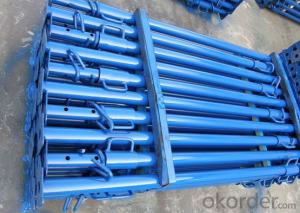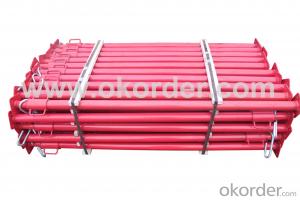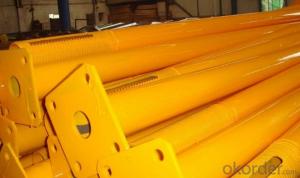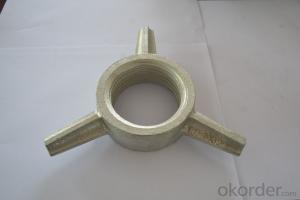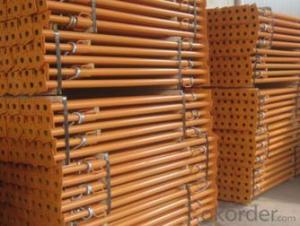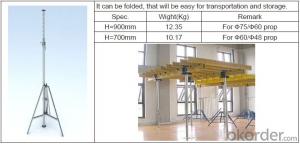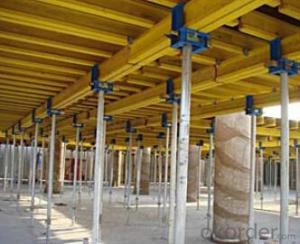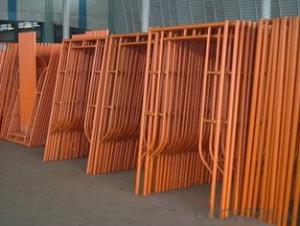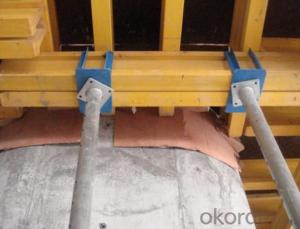manufacturers Scaffolding Steel Prop
- Loading Port:
- China Main Port
- Payment Terms:
- TT OR LC
- Min Order Qty:
- -
- Supply Capability:
- -
OKorder Service Pledge
Quality Product, Order Online Tracking, Timely Delivery
OKorder Financial Service
Credit Rating, Credit Services, Credit Purchasing
You Might Also Like
Quick Details
| Material: | Maint Tube Diameter: | Main Tube Thickness: | |||
| Surface Finished: | Certification: | Color: | |||
| Using Life: | Techique: | Performance: | |||
| Application: |
Packaging & Delivery
| Packaging Detail: | 1.As a practice, steel h frame Scaffolding for sale is bare packed in Container. 2.The packing of frame scaffolding also can be made depend on the customers' need. |
| Delivery Detail: | 10 -15 days after deposit |
Specifications
scaffolding
1.SGS,BV tested h frame scaffolding
2.light frame type
3.best price for sale
4.painting surface, strong welding
| Code | Thickness(mm) | Height(mm) | Width(mm) | Surface Treatment | |
| HF1930 | 2.0/2.2 | 1930 | 1219 | HDG/Painted | |
| HF1700 | 1700 | 1219 | |||
| HF 1524 | 1524 | 1219 | |||
| HF1709 | 1700 | 914 | |||
| LF1700 | 1700 | 1219 | |||
| LF1219 | 1219 | 1219 | |||
| LF914 | 914 | 1219 | |||
| LF1524 | 1524 | 1524 | |||
| LF1930 | 1930 | 1524 | |||
H Frame Scaffolding Accessory
U head jack: 600*34mm/700*30mm solid
Jack base: 600*34mm/700*30mm solid
(the size of nut , head plate can be changed)
walk board:also named planks, 1830mm length, 400mm width, painted
ladder: painted surface, good welded, 2700*442mm
wheel: pp or ruber, 300*150mm/500*150mm with brake
safety net: width:1.8mm, length:6mm. or(L*W): 50*3mm
- Q:Are steel props compatible with different types of scaffolding?
- Yes, steel props are compatible with different types of scaffolding. Steel props are adjustable and versatile support structures that can be used to provide vertical support in various scaffolding systems. They are commonly used to support horizontal beams or platforms, and they can be adjusted to the required height. Steel props are designed to withstand heavy loads and are typically made from high-quality steel, ensuring their compatibility with different types of scaffolding. Whether it is traditional tube and coupler scaffolding, system scaffolding, or frame scaffolding, steel props can be integrated seamlessly to provide the necessary support and stability.
- Q:Can steel props be used for supporting formwork beams?
- Yes, steel props can be used for supporting formwork beams. Steel props are commonly used in construction to provide temporary support to various structures, including formwork beams. They are adjustable, versatile, and capable of bearing heavy loads, making them suitable for supporting formwork beams during construction projects.
- Q:Can steel props be used for supporting prefabricated structures?
- Yes, steel props can be used for supporting prefabricated structures. Steel props are adjustable and sturdy support systems that can be used to provide temporary or permanent support to various types of structures, including prefabricated ones. These props are typically made of high-quality steel and are designed to be strong enough to bear the weight of the structure they are supporting. They can be easily adjusted and secured in place to provide the necessary support during construction or installation of prefabricated structures. Steel props are commonly used in the construction industry for a wide range of applications, including supporting prefabricated structures.
- Q:How do you check the stability of a steel prop?
- To assess the stability of a steel prop, there are several procedures that can be implemented: 1. Begin by conducting a visual examination of the steel prop to identify any visible indications of damage or wear. Look for cracks, dents, or deformations. Furthermore, verify that all prop components are securely fastened and in satisfactory condition. 2. Determine the maximum load capacity of the steel prop as specified by the manufacturer. This information is typically available in the product manual or on the manufacturer's website. Ensure that the load being supported by the prop does not surpass its maximum capacity. 3. If the steel prop can be adjusted in height, verify the proper functioning of the adjustment mechanism. Confirm that the locking pins or screws are firmly in place and capable of maintaining the desired height without slipping or collapsing. 4. Evaluate the stability of the prop's base. Ensure that the base plate or footings are positioned on a stable and level surface. If necessary, employ additional support or stabilization measures like wedges or bracing to prevent any movement or tipping of the prop. 5. Verify the vertical alignment or plumbness of the steel prop. Utilize a spirit level or plumb bob to ascertain that the prop is straight and not leaning to one side. This is crucial to preserve the stability of the structure being supported. 6. Ensure that the load applied to the steel prop is evenly distributed across its supporting surface. Avoid concentrated loads or uneven weight distribution, as this can jeopardize the prop's stability. 7. Engage in regular maintenance to ensure the long-term stability of the steel prop. This may include lubricating moving parts, tightening loose connections, and replacing worn or damaged components. It is important to note that while these steps offer a general guideline, it is always advisable to consult the manufacturer's instructions and adhere to industry best practices when assessing the stability of a steel prop.
- Q:How do you ensure proper anchoring of steel props?
- To ensure proper anchoring of steel props, it is essential to follow these steps: 1. Determine the correct size and length of the steel props according to the load requirements and project specifications. 2. Prepare the ground by removing any loose debris or obstructions that may affect the stability of the props. 3. Dig holes at the designated locations, ensuring they are deep enough to provide sufficient anchorage and stability. 4. Place the steel props vertically into the holes, ensuring they are centered and aligned properly. 5. Backfill the holes with compacted soil or concrete around the steel props to provide a solid support base. 6. Ensure that the props are securely anchored by checking for any movement or instability. If needed, additional reinforcement measures such as adding braces or supports can be implemented. 7. Regularly inspect and monitor the steel props for any signs of damage, deterioration, or movement, and address any issues promptly to maintain their proper anchoring. By following these steps, the proper anchoring of steel props can be ensured, providing a safe and stable support system for various construction and temporary structure applications.
- Q:What are the common applications of steel props?
- Steel props, also referred to as adjustable steel props or steel shore props, have extensive usage in construction and building projects. These props offer temporary support to different structures during construction or renovation endeavors. Listed below are several common applications of steel props: 1. Supporting Formwork: Steel props are extensively utilized for providing support to formwork structures while concrete is being cast. They ensure stability and load-bearing capacity, thereby ensuring the formwork remains in position until the concrete sets. 2. Supporting Slabs and Beams: Steel props are commonly employed for supporting slabs and beams during construction activities. They aid in distributing the load evenly, thereby preventing any potential sagging or collapse of the structure. 3. Shoring and Scaffolding: Steel props are an indispensable component of shoring systems used for stabilizing and supporting excavations, trenches, and walls. They assist in preventing soil movement and maintaining structural integrity during earthworks and foundation construction. 4. Temporary Support: Steel props are utilized as temporary supports when removing load-bearing walls, columns, or beams during renovation or alterations. They offer a secure and adjustable solution to ensure the remaining structure remains stable while the modifications take place. 5. Temporary Roof Support: Steel props are commonly employed for providing temporary support to roofs during repairs or construction. They help in maintaining the structural stability of the building, especially in cases where the existing roof structure has been compromised. 6. Mezzanine and Raised Floor Support: Steel props are utilized for supporting mezzanine floors and raised platforms, ensuring stability and load-bearing capacity. They aid in distributing the weight of the floor and any additional loads to the foundation or lower level. 7. Support for Pipes and Ducts: Steel props are used for supporting pipes, ducts, and other utilities during installation or maintenance. They prevent sagging or movement of these systems, ensuring proper alignment and support. In conclusion, steel props find a wide range of applications in construction projects, including formwork support, slab and beam support, shoring and scaffolding, temporary support, temporary roof support, mezzanine and raised floor support, and pipe and duct support. Their adjustability, load-bearing capacity, and versatility make them a dependable choice for providing temporary support during various construction activities.
- Q:Are steel props suitable for supporting temporary stages or platforms with moving parts?
- Steel props are commonly used to support temporary stages or platforms that have moving parts. They possess great strength, durability, and the ability to bear heavy loads, making them an ideal choice for providing stability and support to temporary structures. Furthermore, steel props can be easily adjusted to various heights, allowing for customization and adaptability to the specific needs of the stage or platform. However, it is crucial to ensure the proper securing and bracing of the steel props to prevent any potential movement or instability. It is also important to regularly inspect and maintain the props to detect any signs of wear or damage that may compromise their integrity. When used correctly and maintained appropriately, steel props can be relied upon as a dependable and efficient option for supporting temporary stages or platforms with moving parts.
- Q:Are steel props suitable for supporting temporary bridges or walkways over water bodies?
- Yes, steel props are suitable for supporting temporary bridges or walkways over water bodies. Steel props are strong, durable, and able to withstand heavy loads, which makes them ideal for supporting temporary structures like bridges or walkways. They provide stability and ensure the safety of pedestrians or vehicles crossing over water bodies. Additionally, steel props can be easily adjusted and customized to meet specific height or length requirements, making them versatile for various types of temporary structures. Overall, steel props are a reliable choice for supporting temporary bridges or walkways over water bodies.
- Q:How do steel props contribute to the prevention of structural vibrations?
- Steel props, also known as temporary supports, play a crucial role in preventing structural vibrations. These props provide additional stability and support to existing structures, particularly during construction or renovation projects. By effectively transferring the load and distributing the weight evenly, steel props help to reduce excessive movement and oscillations, thereby minimizing the risk of structural vibrations.
- Q:Are steel props compatible with different types of ground conditions?
- Yes, steel props are compatible with different types of ground conditions. Steel props are adjustable and can be extended or shortened to suit the specific ground conditions, making them suitable for a variety of terrains such as soft soil, rocky surfaces, or uneven ground.
1. Manufacturer Overview |
|
|---|---|
| Location | |
| Year Established | |
| Annual Output Value | |
| Main Markets | |
| Company Certifications | |
2. Manufacturer Certificates |
|
|---|---|
| a) Certification Name | |
| Range | |
| Reference | |
| Validity Period | |
3. Manufacturer Capability |
|
|---|---|
| a)Trade Capacity | |
| Nearest Port | |
| Export Percentage | |
| No.of Employees in Trade Department | |
| Language Spoken: | |
| b)Factory Information | |
| Factory Size: | |
| No. of Production Lines | |
| Contract Manufacturing | |
| Product Price Range | |
Send your message to us
manufacturers Scaffolding Steel Prop
- Loading Port:
- China Main Port
- Payment Terms:
- TT OR LC
- Min Order Qty:
- -
- Supply Capability:
- -
OKorder Service Pledge
Quality Product, Order Online Tracking, Timely Delivery
OKorder Financial Service
Credit Rating, Credit Services, Credit Purchasing
Similar products
New products
Hot products
Hot Searches
Related keywords
